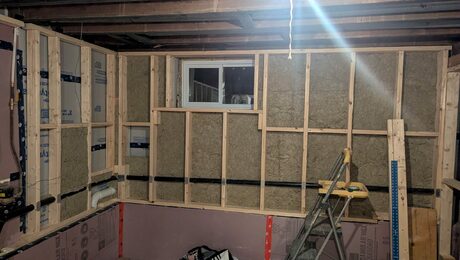Water vapor with wall Assembly with MGO
Hello folks, really appreciate this forum.
We’re building a modular home at zomes.com. This is a CAD of our latest model: https://autode.sk/3VeAzdT
Our wall assembly is composed of the following layers from the EXTERIOR to the interior:
1. (outermost) 1/2 inch fiber cement board
2. 1/2 inch zip board structural panel (taped with ziptape)
3. 1.5 inch continuous rigid insulation
4. 3 inch douglas fir frame with 3 inch rockwool comfort board in the insulation
5. 1/4 inch interior decorative panel
We are wanting to replace the 1/2 inch zip board with a 1/2 inch MgO structural panel. The concern being raised is that the MgO panel may not be breathable. And will therefore trap moisture from inside the building, which will condense from the inside of the board, and get trapped there. Creating mold on the framing.
My limited understanding of vapor is that it won’t get trapped on the inside and will diffuse back into the building.
Can anyone shed some light on this?
Much appreciated!
Here are the relevant spec sheets:
Magnesium oxide panel:
https://www.rockmaxboard.com/structural-mgo-sheathing/
Rigid insulation: https://drive.google.com/file/d/1ybYdAP32vcI5uoPPDu4bHvxh7lTuJFq4/view
Rockwool Comfortboard:
https://www.rockwool.com/syssiteassets/o2-rockwool/documentation/technical-data-sheets/residential/comfortboard-80-non-structural-sheathing-continuous-insulation-techdata.pdf


















Replies
Here is the first problem I saw immediately regardless of what you are using for the sheathing layer. If the outside temperature drops below the dewpoint you will get moisture, meaning liquid condensing on the inside sheathing surface and that will promote wood rot in the framing members.
The insulation in the framing member spaces/cavities doesn't provide the insulation value you think it does. The wood framing members create a thermal bridge to the outside. If you used 3 inches of Rook wool you might get an insulation value of 15 but with the thermal bridging that is reduced to 11 or 12. The way you prevent the wood rot, thermal bridging and still get a tight enclosure is by putting the Comfort Board on the outside and in two layers with the seams offset. Can't effectively tape Comfort Board so why not use a polyiso in two layers with taped seams and offsetting seams. The sheathing stays warm and no condensation occurs on the inside.
How are you going to prevent water from coming into the exterior layers when you cannot seal the joints in the cement board? Overlapping will not prevent wind driven rain from getting in and a stucco finish will not prevent wind driven rain from getting in either. So how are you going to keep out the water or mitigate the water that gets into the exterior layers?
The design is going to cost a lot in labor to build.